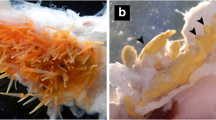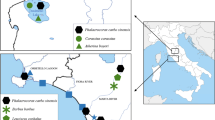Abstract
Gyrodactylus infections in intensively-reared populations of Nile tilapia, Oreochromis niloticus niloticus, have been associated world-wide with high mortalities of juvenile fish. In this study, 26 populations of Gyrodactylus parasitising either O. n. niloticus or Mozambique tilapia, Oreochromis mossambicus, were sampled from fourteen countries and compared with type material of Gyrodactylus cichlidarum Paperna, 1968, Gyrodactylus niloticus (syn. of G. cichlidarum) and Gyrodactylus shariffi Cone, Arthur et Bondad-Reantaso, 1995. Representative specimens from each population were bisected, each half being used for morphological and molecular analyses. Principal component analyses (PCA) identified five distinct clusters: (1) a cluster representing G. cichlidarum collected from O. n. niloticus from 13 countries; (2) the G. shariffi paratype; (3) three specimens with pronounced ventral bar processes collected from two populations of Mexican O. n. niloticus (Gyrodactylus sp. 1); (4) four specimens collected from an Ethiopian population nominally identified as O. n. niloticus (Gyrodactylus sp. 2); (5) nine gyrodactylids from South African O. mossambicus (Gyrodactylus sp. 3). Molecular analyses comparing the sequence of the ribosomal transcribed spacer regions (ITS 1 and 2) and the 5.8S gene from the non-hook bearing half of worms representative for each population and for each cluster of parasites, confirmed the presence of G. cichlidarum in most samples analysed. Molecular data also confirmed that the DNA sequence of Gyrodactylus sp. 2 and Gyrodactylus sp. 3 (the morphologically-cryptic group of South African specimens from O. mossambicus) differed from that of G. cichlidarum and therefore represent new species; no sequences were obtained from Gyrodactylus sp. 1. The current study demonstrates that G. cichlidarum is the dominant species infecting O. n. niloticus, being found in 13 of the 15 countries sampled.
Similar content being viewed by others
References
Bauer O.N., Pugachev O.N., Voronin V.N. 2002. Study of parasites and diseases of sturgeons in Russia: a review. Journal of Applied Ichthyology, 18, 420–429. DOI: 0175-8659/2002/1804-06-0420.
Bunkley-Williams L., Williams E.H.R., Jr. 1994. Parasites of Puerto Rican freshwater sport fishes. Puerto Rico. Department of Natural and Environmental Resources, San Juan, Puerto Rico and Department of Marine Sciences, University of Puerto Rico, Mayaguez, Puerto Rico, 168 pp.
Cone D.K., Arthur J.R., Bondad-Reantaso M.G. 1995. Description of two new species of Gyrodactylus von Nordmann, 1832 Monogenea) from cultured Nile tilapia, Tilapia nilotica (Cichlidae), in the Philippines. Journal of the Helminthological Society of Washington, 62, 6–9.
El-Naggar A.A., El-Tantawy S.A. 2003. The dynamics of gill monogenean communities on cichlid fish hosts inhabiting Damietta Branch of the River Nile: long-term changes in species richness and community structure. Journal of the Egyptian-German Society of Zoology, 41D, 187–220 [Arabic summary].
FAO. 2006. The state of aquaculture fisheries and aquaculture. FAO Fisheries and Aquaculture Department Food Agriculture Organization of the United Nations Rome, 2007.
Fitzsimmons K. 2006. Prospect and potential for global production. In: (Eds. C.E. Lim and B.L. Webster) Tilapia Biology, Culture and Nutrition. Chapter 2. Second edn., Food Products Press 51–72.
García-Vásquez A., Hansen H., Shinn A.P. 2007. A revised description of Gyrodactylus cichlidarum Paperna, 1968 (Gyrodactylidae) from the Nile tilapia, Oreochromis niloticus niloticus (Cichlidae) and its synonymy with G. niloticus Cone, Arthur et Bondad-Reantaso, 1995. Folia Parasitologica, 54, 129–140.
García-Vásquez A., Hansen H., Bron J.E., Shinn A.P. 2010. Description of three new species of Gyrodactylus von Nordmann, 1832 (Monogenea) described from Oreochromis niloticus niloticus (L.) and O. mossambicus (Peters) (Cichlidae), (submitted).
Hansen H., Bachmann L., Bakke T.A. 2003. Mitochondrial DNA variation of Gyrodactylus spp. (Monogenea, Gyrodactylidae) populations infecting Atlantic salmon, grayling and rainbow trout in Norway and Sweden. International Journal for Parasitology, 33, 1471–1478. DOI: 10.1016/S0020-7519(03)00200-5.
Harris P.H., Shinn A.P., Cable J., Bakke T.A. 2004. Nominal species of the genus Gyrodactylus von Nordmann 1832 (Monogenea: Gyrodactylidae), with a list of principal host species. Systematic Parasitology, 59, 1–27. DOI: 10.1023/B:SYPA.0000038447.52015.e4.
Johnsen B.O., Jensen A.J. 1991. The Gyrodactylus story in Norway. Aquaculture, 98, 289–302. DOI: 10.1016/0044-8486(91)90270-H.
López-Jímenez S. 2001. Estudio parasitológico de los peces de aguas dulces del Estado de Tabasco. Gaceta Sigolfo Sistema de Investigación del Golfo de México, 8–10.
Matějusová I., Gelnar M., McBeath A.J.A., Collins C.M., Cunningham C.O. 2001. Molecular markers for gyrodactylids (Gyrodactylidae: Monogenea) from five fish families (Teleostei). International Journal for Parasitology, 31, 738–745. DOI: 10.1016/S0020-7519(01)00176-X.
Mo T.A. 1994. Status of Gyrodactylus salaris problems and research in Norway. In: (Eds. A.W. Pike and J.W. Lewis) Parasitic Diseases of Fish. Samara Publishing Limited, Dyfed, UK, 43–58.
Muñoz-Córdova G., Garduño-Lugo M. 2003. Mejoramiento genético en tilapia: sistemas de cruzamiento y mecanismos genéticos en la determinación de color. Veracruz: Facultad de Medicina Veterinaria y Zootecnia de la Universidad Nacional Autónoma de México. Sistema de Investigación del Golfo de México del Consejo Nacional de Ciencia y Tecnología, 84 pp.
Paperna I. 1968. Monogenetic trematodes collected from fresh water fish in Ghana second report. Bamidgeh, 20, 88–90.
Paperna I. 1973. New species of Monogenea (Vermes) from African freshwater fish. A preliminary report. Revue de Zoologie et de Botanique Africaines, 87, 505–518.
Paperna I. 1979. Monogenea of inland water fishes in Africa. Museé Royal de l’Afrique Centrale, Tervuren, Ser. 8, 226, 1–127.
Přikrylovějusova I., Musilová I., Gelnar M. 2009. Gyrodactylus species (Monogenea: Gyrodactylidae) on the cichlid fishes of Senegal, with the description of Gyrodactylus ergensi n. sp. from Mango tilapia, Sarotherodon galilaeus L. (Teleostei: Cichlidae). Parasitology Research, 106, 1–6. DOI: 10.1007/s00436-009-1600-0.
Rohde K. 1984. Ecology of marine parasites. Helgoländer Meeresuntersuchungen, 37, 5–33.
Salgado-Maldonado G., Pineda-López R., García-Magaña L., López-Jiménez S., Vidal-Martínez V.M., Aguirre-Macedo M.L. 2005. Helmintos parásitos de peces dulceacuícolas. In: (Eds. J. Bueno, F. álvarez and S. Santiago) Biodiversidad del Estado de Tabasco. Instituto de Biología, Universidad Nacional Autónoma de México. Mexico, D.F., 145–166.
Shinn A.P., des Clers S., Gibson D.I., Sommerville C. 1996. Multivariate analyses of morphometrical features from Gyrodactylus spp. (Monogenea) parasitising British salmonids: light microscope based studies. Systematic Parasitology, 33, 115–125. DOI: 10.1007/BF00009427.
Shinn A.P., Hansen H., Olstad K., Bachmann L., Bakke T.A. 2004. The use of morphometric characters to discriminate specimens of laboratory-reared and wild populations of Gyrodactylus salaris and G. thymalli (Monogenea). Folia Parasitologica, 51, 239–252.
Suresh V. 2003. Tilapias. In: (Eds. J.S. Lucas and P.C. Southgate) Aquaculture, Farming Aquatic Animals and Plants. Blackwell Publishing Company, Oxford, 321–345.
Tamura K., Dudley J., Nei M., Suhdhir K. 2007. MEGA4: Molecular Evolutionary Genetics Analysis (MEGA) Software version 4.0. Molecular Biology and Evolution, 24, 1596–1599. DOI: 10.1093/molbev/msm092.
Thoney D.A., Hargis W.J., Jr. 1991. Monogenea (Platyhelminthes) as hazards for fish in confinement. Annual Review of Fish Diseases, 1, 133–153. DOI: 10.1016/0959-8030(91)90027-H.
Whittington I. 2004. The Capsalidae (Monogenea: Monopisthocotylea): a review of diversity, classification and phylogeny with a note on species complexes. Folia Parasitologica, 51, 109–122.
Zhang Z., Schwartz S., Wagner L., Miller W. 2000. A greedy algorithm for aligning DNA sequences. Journal of Computational Biology, 7, 203–214. DOI: 10.1089/10665270050081478.
Ziętara M., Lumme J. 2003. The crossroads of molecular typological and biological species concepts: two new species of Gyrodactylus Nordmann, 1832 (Monogenea: Gyrodactylidae). Systematic Parasitology, 55, 39–52. DOI: 10.1023/A:1023938415148.
Author information
Authors and Affiliations
Corresponding author
Rights and permissions
About this article
Cite this article
García-Vásquez, A., Hansen, H., Christison, K.W. et al. Gyrodactylids (Gyrodactylidae, Monogenea) infecting Oreochromis niloticus niloticus (L.) and O. mossambicus (Peters) (Cichlidae): A pan-global survey. Acta Parasit. 55, 215–229 (2010). https://doi.org/10.2478/s11686-010-0042-2
Accepted:
Published:
Issue Date:
DOI: https://doi.org/10.2478/s11686-010-0042-2




